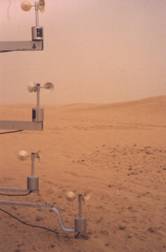Axis 1: Modeling of mineral dust emissions in arid and semi-arid areas
|
Our work is devoted to the understanding and modeling of the process of mineral dust emissions by wind erosion of surfaces in arid and semi-arid regions. Physical models, describing the main steps involved in the production of mineral dust have been developed and improved over the past years. These modeling jobs rely in part on wind tunnel experiments, dedicated to the study of the process, and validation field campaigns documenting the key parameters (emission flux, size distribution,…). The quantification of dust emissions from arid areas around the globe is based on the application of these physical models at a large scale. This requires in particular the development of methods of mapping of the states of surface of the regions concerned (deserts of Northern Africa and northeastern Asia, Sahel area …), particularly from satellite data. Specific attention is also paid to the quality of surface winds provided by the meteorological models.
Figure 2: Average of annual emissions (1996-2001) simulated on the Sahara (in tons) using the emission model and maps of state of surface developed at LISA, and weather data from the European Center for Medium-Range Weather Forecasts (ECMWF) (from Laurent et al., 2008). |
Figure 1: Sandstorms and dust in the Southern Tunisia (Douz). |
To deal with the more complex case of the semi-arid areas specific approaches are developed, in particular to take into account the dynamics of naturally vegetated and cultivated surfaces.
The European program AMMA (African Monsoon Multidisciplinary Analysis) allowed us to work intensively on the semi-arid Sahelian zone. This region is peculiar as local emissions are mainly related to the convective activity that develops in monsoon season. They are therefore quite systematically associated to the wet deposit by precipitations. A quantification of the exportable "net" emissions from the Sahel therefore requires estimating the budget between emission and deposition associated with convective systems.
=> Emission model in arid zones
=> Simulation of emissions in arid zones
=> Emissions from semi-arid areas
=> Quantification of exportable "net" emissions: the case of the Sahel



